
Selenicereus undatus, the white-fleshed pitahaya, is a species of Cactaceae and is the most cultivated species in the genus. It is used both as an ornamental vine and as a fruit crop - the pitahaya or dragon fruit. The native origin of the species has never been resolved.
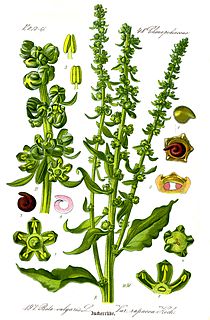
Beta is a genus in the flowering plant family Amaranthaceae. The best known member is the common beet, Beta vulgaris, but several other species are recognised. Almost all have common names containing the word "beet". Wild Beta species can be found throughout the Atlantic coast of Europe, the Mediterranean coastline, the Near East, and parts of Asia including India.

Salsola is a genus of the subfamily Salsoloideae in the family Amaranthaceae. The genus sensu stricto is distributed in central and southwestern Asia, North Africa, and the Mediterranean. A common name of various members of this genus and related genera is saltwort, for their salt tolerance. The genus name Salsola is from the Latin salsus, meaning "salty".
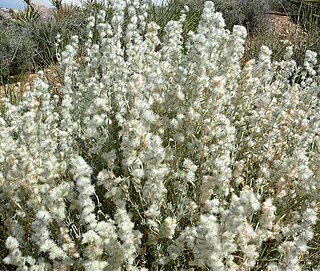
Krascheninnikovia is a genus of flowering plants in the subfamily Chenopodioideae of the family Amaranthaceae known as winterfat, so-called because it is a nutritious livestock forage. They are known from Eurasia and western North America. These are hairy perennials or small shrubs which may be monoecious or dioecious. They bear spike inflorescences of woolly flowers.

Halothamnus is a genus in the subfamily Salsoloideae of the family Amaranthaceae. The scientific name means saltbush, from the Greek ἅλς (hals) "salt" and θαμνος (thamnos) "bush". This refers either to salty habitats or to the accumulation of salt in the plants. The genus is distributed from Southwest and Central Asia to the Arabian peninsula and East Africa.

Halothamnus subaphyllus is a species of the plant genus Halothamnus, that belongs to the subfamily Salsoloideae within the family Amaranthaceae,. It occurs in Southwest and Central Asia.

Halothamnus glaucus is a species of the plant genus Halothamnus, that belongs to the subfamily Salsoloideae of the family Amaranthaceae,. It occurs in Western and Central Asia.

Halothamnus auriculus is a species of the plant genus Halothamnus, that belongs to the subfamily Salsoloideae of the family Amaranthaceae,. It occurs in Western and Middle Asia.

Halothamnus beckettii is a species of the plant genus Halothamnus, that is now included into the family Amaranthaceae,. It is the only member of the section H. sect. Pungentifolia, which differs from H. sect. Halothamnus by hard leaves with spiny apex. It is endemic to Somalia.
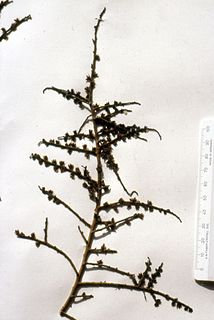
Halothamnus somalensis is a species of the plant genus Halothamnus, that is now included into the family Amaranthaceae,. It is endemic to the Horn of Africa and is used for traditional medicine.

Halothamnus bottae is a species of the plant genus Halothamnus, that belongs to the subfamily Salsoloideae of the family Amaranthaceae. It occurs on the Arabian peninsula.
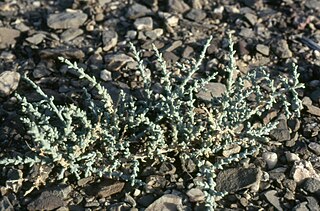
Halothamnus iranicus is a species of the plant genus Halothamnus, that belongs to the subfamily Salsoloideae of the family Amaranthaceae,. It occurs in Southwest Asia.

Halothamnus hierochunticus is a species of the plant genus Halothamnus, that belongs to the subfamily Salsoloideae within the family Amaranthaceae,. It occurs in Southwest Asia and is partly considered as a weed.

Halothamnus iliensis is a species of the plant genus Halothamnus, that belongs to the subfamily Salsoloideae of the family Amaranthaceae,. It occurs in Central Asia.
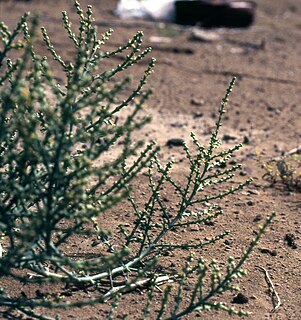
Seidlitzia stocksii is a shrub species of the family Amaranthaceae.
Anabasis is a genus of plants in the subfamily Salsoloideae of the family Amaranthaceae. It is distributed in southern Europe, North Africa, and Asia.

Dysphania is a plant genus in the family Amaranthaceae, distributed worldwide from the tropics and subtropics to warm-temperate regions.

Suaeda aegyptiaca is a species of succulent plant in the family Amaranthaceae, and salt-tolerant (halophyte) plant that is distributed in eastern North Africa, the Near East and West Asia.

Stutzia is a plant genus in the subfamily Chenopodioideae of the family Amaranthaceae. It was described in 2010, replacing the illegitimate name Endolepis. It comprises two species, that have also been included in the genus Atriplex.
Proatriplex is a monotypic plant genus in the subfamily Chenopodioideae of the family Amaranthaceae, with the only species Proatriplex pleiantha. It is known by the common names Four-corners orach and Mancos shadscale. It occurs in the Navajo Basin of Arizona, Colorado, New Mexico, and Utah.



















